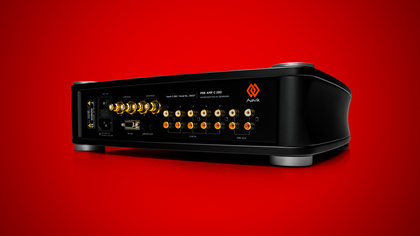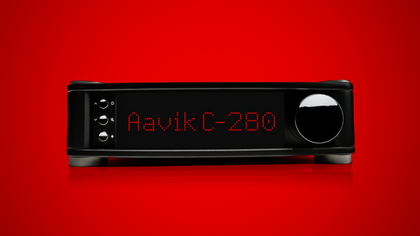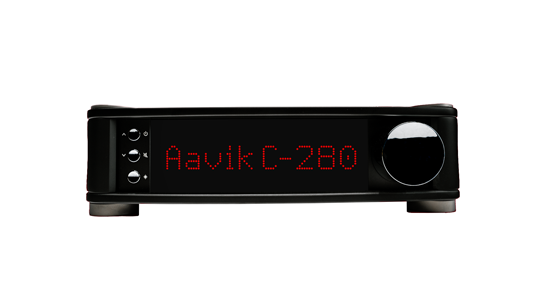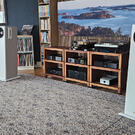It’s been a while since we last visited the cheerful Danes at Audio Group Denmark who are behind the electronics from Aavik, and now we finally have access to one of their amplifier sets. We start with the Aavik c-280 preamplifier. On the following pages you can read about P-280, and not least how these two matching products play together.

Modern design
Much can be said about Aavik’s design, but there are very good reasons that it is built in this way. Aavik believes the enclosure of any product must be built like an instrument. Too much dampening in the enclosure kills the dynamic, while excessive use of metal creates a sharp and high tone. Therefore, a composite material is used that is made in carefully calculated sizes and shapes that define the enclosure’s tone for warm and harmonic sound that is also focused and defined.
The display on the front is immediately recognisable. The large characters are readable a mile off, but the brightness can be turned down from 100 to 10%, which means that you can go from having your living room coloured red at night to being barely visible.
Control takes place with an Apple remote that is paired with your amplifier, but which also works with the Apple TV unit – at the same time. If you have a TV and an Apple TV unit in your living room, this makes for less clutter. The remote controls a number of functions such as volume, balance, split frequency, low pass volume, low and high pass frequency and HT bypass on/off and volume.
There are plenty of line inputs. There are five of these on the rear in addition to a couple of analogue outputs, but then it also has both low and high pass outputs from the analogue crossover. It can therefore also be used in a 2.1 system, and as an amplifier in a home theatre system with connected subwoofers. The benefit is obvious. You can use your carefully adjusted subwoofers both when playing music and your home theatre. Bu we’ll return to that.
Like Aavik’s other amplifiers, good and sturdy feet are fitted, but in each corner, including on the underlying feet, there is room for the Darkz feet from sister brand Anzus.
It’s full of Tesla coils
What’s a Tesla coil doing in an amplifier? According to Aavik – quite a lot. The principle of the Tesla coils is that two coils are fitted that are wound in different directions, i.e. a coil and a counter coil. Both of the coils have voltage, and when the Tesla coil encounters a voltage spike, a counter spike is activated to eliminate noise. Since noise spikes are pure voltage, cancellation is quite good, but not completely 100%, according to Aavik. By adding several coils in parallel, performance increases with the result that the perceived blackness, or the silence in the music’s background, increases significantly. To be on the safe side, there are no fewer than 72 Tesla coils in the amplifier.

Analog crossover
The built-in crossover is handy when connecting a subwoofer in a 2.1 system or powering the fronts in the home theatre. The analogue composition means that the incoming signal doesn’t need to be converted to digital. According to Aavik, this means less delay because they avoid the digital circuits’ and the DSPs’ delay of 15-20 milliseconds. This means greater precision and better sound. When you get to a level of quality like this, the precision between the bass and midrange is critical, and we don’t want phase issues that make the transition less precise than it should be.
The volume of the low and high pass filter can be separately adjusted, and you can adjust the subwoofer and stereo speakers to perfection from the comfort of your sofa. This requires that you have a separate power amplifier connected to the low pass output and a subwoofer to the high pass output. This provides good and flexible opportunities to customise a subwoofer. But there is also a feature of such a configuration that many perhaps may not think of. A low and high pass filter can also be used as an analogue room correction if you have managed to identify the room modes in the listening room in advance. By allowing you to set the split frequency on both the high and low pass filters, you can also set the filter on either side of a room mode. If you have one at 80 Hz, a filter setting of 60 and 100 Hz respectively together with separate volume, could dampen the room mode in the middle. This is just an example, but does nevertheless provide a hint on the procedure.
This removes the all to familiar “boom” effect that arises when your room plays along and produces a disturbing room mode, and if you’re thinking that this can be fixed by various bass traps, this is very much easier to achieve.

Sound
It takes a matter of seconds to reveal the qualities of this preamplifier. It’s just as quiet as Aavik claims, and it’s like a black hole in the background of the soundscape. It provides fantastic insight into the soundscape, a presentation of details that is both distinct and relaxed at the same time, and very generous space for both instruments and voices. The focus is excellent, and you are served a particularly well-defined and orderly three-dimensional soundscape with impressive depth and width.
C-280 has a soundscape that is extremely transparent and open, and finally I have the feeling that there is nothing at all between me and the music being presented. Not even a hint of a veil and completely without filtering or scenting. The sound is neutral, extremely musical and credible, and surprisingly relaxed considering the large volume of detail the preamplifier presents. The complete transparency and insight into the soundscape allow the details to emerge beautifully. Completely without the need for the unappealing floodlighting we often hear, and which does little other than create an overstated and analytic soundscape. It is of course a matter of taste, but C-280 proves that it is fully possible to have two qualities in place at the same time. Great ability to play details, while at the same time having a musical and naturally-sounding soundscape.
The ability to create music out of complex soundscapes is one of the things you get for your money when you invest in the price range of the C-280. I play Wagner’s Lohengrin (Abbado/ Vienna Philharmonic Orchestra), and it’s impressive how the preamplifier accommodates all of the musicians, how incredibly beautiful and big it sounds and how realistically the orchestra is placed in the concert hall. The unity also gives the impression that there are more musicians at work than usual. The strings sound is rich and complex and the wind section has the proper brass sound, but most impressive is nevertheless how organic, orderly and relaxed everything sounds. At the same time there is a significant dynamic vigour and an impressive number of details that elevate the listening experience to great heights.
I often use Phoebe Bridges when testing. Her fantastic voice makes everything sound good, but if it is to be lifted right up where it belongs, the electronics must be incomparable. Her Garden Song is given a few turns on the player, and I immediately get the same feeling as when Wagner flowed from the speakers. The huge insight into the soundscape, the meticulous attention to detail and the natural and precise reproduction significantly cleans up the beginning of the track, and when the voice enters the frame it is so utterly pure that it immediately leads to an uncontrolled outbreak of goosebumps. It is so naked, close and sonorous that it has exactly the same effect on the nervous system even after repeated playbacks. At the same time it’s not too light, aggressive or insistent. It just is, and it’s beautiful.
Conclusion
One should always take claims from manufacturers with a grain of salt, but try as you might to reveal weaknesses in C-280, all attempts come crashing to the ground when you start to play music on this preamplifier. It exists in the elusive area between the analytical and slightly warm or coloured area. It plays with great conviction, and sometimes you get the feeling that it has a will of its own that it imposes on all music it transmits. Control is also complete at the very bottom of the bass area, and the midrange has a vibrant and highly credible, yet relaxed dynamic, that creates engagement, a strong listening pleasure and an uncontrollable desire to stomp the beat.

 Vipps oss en gave: 129702
Vipps oss en gave: 129702



